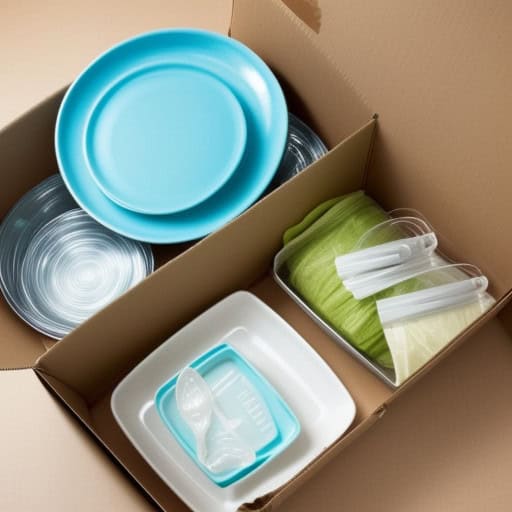According to professional packer with over a decade of experience Rodriguez,“Packing dishes for shipping requires careful attention to ensure their safe arrival.”
Are you preparing to ship your cherished dishes to a new home or sending them as a gift to a loved one?
Packing fragile items for shipping can be a daunting task, as you want to ensure their safe arrival without any damage or breakage.
From selecting the right materials to arranging them strategically in boxes, we’ll guide you through each step of the process.
Don’t risk the disappointment of shattered plates or chipped bowls—read on to discover the tried-and-true methods that will give you peace of mind and guarantee the safe delivery of your precious tableware.
Your dishes deserve the utmost care, and we’re here to provide you with the knowledge and expertise you need.
Key Takeaways
- Use sturdy, appropriately sized boxes and plenty of cushioning materials such as bubble wrap, packing paper, or foam inserts to protect dishes from impact during transit.
- Pack dishes vertically, layering them with padding in between and around each item to prevent shifting and breakage.
- Seal boxes securely with packing tape and clearly label them as fragile to ensure careful handling during shipping.
Essential Packing Materials
Source: Prime Time Treasure Hunter
Choosing the Right Supplies
When it comes to packing dishes for shipping, having the right materials is crucial to ensure your precious items arrive safely at their destination. Here are the essential supplies you’ll need:
- Sturdy cardboard boxes: Choose double-walled boxes designed for shipping. Avoid used boxes, as they may be weakened and provide less protection.
- Bubble wrap: This versatile material provides excellent cushioning and shock absorption for your dishes. Opt for high-quality bubble wrap with large air pockets.
- Packing peanuts: These lightweight, static-free packing fillers are ideal for filling gaps and preventing your dishes from shifting during transit.
- Packing paper: Sheets of clean, acid-free packing paper are perfect for wrapping individual dishes and preventing scratches or scuffs.
- High-quality packing tape: Invest in a strong, wide packing tape designed for shipping. This will ensure your boxes remain securely sealed during transportation.
Additionally, you may want to consider the following optional supplies for added protection:
- Dish dividers or cardboard inserts: These specialized inserts help separate and secure plates, bowls, and other dishes within the box.
- Foam pouches or wrap: Extra cushioning material like foam pouches or wrap can provide an additional layer of protection for your most fragile items.
By having the right packing materials on hand, you can ensure your dishes are properly cushioned, secured, and protected during the shipping process, minimizing the risk of damage or breakage.
Wrapping and Padding Techniques
Ensuring Secure Cushioning
Proper wrapping and padding are essential to protect your dishes during shipping. Here’s how to ensure secure cushioning:
- Individual wrapping: Take the time to wrap each dish individually in multiple layers of bubble wrap or packing paper. This creates a protective cocoon around each item, absorbing any potential impacts during transit.
- Wrapping techniques: For plates and bowls, place them face-down on a flat surface and wrap them tightly with the padding material, ensuring no part is left exposed. For mugs and glasses, stuff the interior with crumpled packing paper before wrapping the exterior.(1)
- Securing the wrap: Once wrapped, secure the padding material with packing tape. This prevents the wrap from coming undone during shipping.
- Fill empty spaces: After placing the wrapped dishes in the box, fill any remaining gaps or empty spaces with packing peanuts or additional crumpled packing paper. This prevents the items from shifting or moving around during transit.
Here are some additional tips for effective padding:
- Use multiple layers: For extra fragile items, consider using multiple layers of bubble wrap or combining bubble wrap with packing paper for added protection.
- Opt for dish dividers: If you have dish dividers or cardboard inserts, place them between each wrapped item to create additional separation and cushioning.
- Tape placement: When taping the wrapped dishes, avoid placing tape directly on the item’s surface to prevent residue or damage.
By following these wrapping and padding techniques, you can significantly reduce the risk of damage to your dishes during shipping, ensuring they arrive at their destination safely and intact.
Selecting and Sealing Boxes
Optimal Box Selection and Sealing
Choosing the right box and properly sealing it are crucial steps in ensuring the safe delivery of your dishes. Here are some tips to keep in mind:
- Box Size: Select a box slightly larger than the dimensions of your wrapped and padded dishes. This allows for sufficient space to add extra padding material and prevent items from shifting during transit.(2)
- Double-Boxing Technique: For extra protection, consider double-boxing your fragile items. This involves placing the sealed, padded box containing your dishes into a slightly larger outer box, filling the remaining space with additional cushioning material.
- Sealing the Box: Once your dishes are securely packed and cushioned within the box, it’s time to seal it up. Use a strong, wide packing tape designed for shipping purposes. Apply the tape to all seams and edges, overlapping the tape for added reinforcement.
- Tape Placement: When sealing the box, ensure the tape extends at least 3-4 inches onto the sides of the box. This prevents the seams from opening during transit.
Here are some additional tips for optimal box selection and sealing:
- Reinforce the Bottom: For heavier boxes, consider reinforcing the bottom with an extra layer of tape or using a double-walled cardboard box for added strength.
- Label the Box: Clearly label the box with the recipient’s address and your return address. Include markings like “Fragile” or “Handle with Care” to alert carriers to handle the package with extra caution.
- Avoid Used Boxes: While recycling is commendable, used boxes may have weakened corners or seams, compromising the overall integrity of the packaging.
By selecting the appropriate box size, utilizing the double-boxing technique for fragile items, and meticulously sealing the boxes with strong packing tape, you can significantly reduce the risk of damage during shipping and ensure your dishes arrive safely at their destination.
Comprehensive Guide to Packing Dishes for Shipping
Preparation Steps
- Wash and dry dishes thoroughly before packing to ensure they are clean and free of any residue or moisture that could cause damage during transit.
- Create an initial cushion layer by padding the bottom of the box with packing peanuts, crumpled packing paper, or bubble wrap. This provides a soft, protective base for your dishes.
Wrapping Techniques
- Wrap each dish individually in several layers of bubble wrap or clean packing paper. The more padding, the better protection against impacts and scratches.
- Secure the wrap tightly around each dish using packing tape. This prevents the wrap from loosening or coming undone during shipping.
Box Placement and Filling
- Place larger, heavier dishes on the bottom of the box and lighter items on top. This distributes the weight evenly, preventing crushing or damage to delicate pieces.
- Utilize dish dividers or cardboard inserts to create compartments if you’re packing multiple dishes together. This separates items and prevents them from rubbing against each other during transit.
- Fill any remaining gaps or spaces with packing peanuts, crumpled paper, or extra bubble wrap. This eliminates shifting and movement within the box.
Sealing and Labeling
- Seal the box securely using strong packing tape along all seams, edges, and openings. This prevents the box from opening or contents from spilling out during shipping.
- Clearly label the box as “Fragile” on multiple sides using a permanent marker. You can also write “This Side Up” to ensure proper handling.
By following these comprehensive steps, you can significantly increase the chances of your dishes arriving safely at their destination, ensuring a stress-free shipping experience.
Additional Tips for Safe Shipping
While following the proper packing techniques is crucial, there are a few additional steps you can take to ensure the safe shipping of your dishes:
Insurance and Documentation
- Consider purchasing insurance for valuable or irreplaceable dishes. Many shipping carriers offer affordable insurance options to protect against loss or damage during transit.
- Take photographs of the dishes before packing them. These visual records can serve as documentation if any damage occurs during shipping, making it easier to file a claim.
Original Packaging and Minimalism
- Use the original packaging for your dishes whenever possible. These packages are specifically designed to protect the items during shipping and transportation.
- Embrace a minimalist approach to packing. Avoid using excessive amounts of packing materials, as this can add unnecessary bulk and weight to the package, potentially increasing shipping costs.
Here are some additional tips to keep in mind:
- Use a reputable shipping carrier with experience in handling fragile items. Research their policies and procedures for shipping delicate goods.
- Consider shipping dishes in multiple boxes if you have a large quantity. This distributes the weight and reduces the risk of a single box becoming too heavy or unwieldy.
- Include a packing slip or inventory list inside the box, detailing the contents and their condition before shipping.
- Opt for faster shipping methods for valuable or time-sensitive shipments to minimize the time your dishes are in transit.
By following these additional tips and taking extra precautions, you can further mitigate the risks associated with shipping dishes, ensuring a smooth and stress-free experience from start to finish.
Conclusion
Mastering the art of packing dishes for shipping opens doors to a world of safe and secure deliveries.
By following simple yet effective techniques, you can ensure your precious items reach their destination intact.
Remember to prioritize sturdy packing materials, thorough wrapping, and strategic box selection.
These small steps can make a significant difference in safeguarding your dishes from damage during transit.
So, whether you’re sending heirloom china or everyday dinnerware, embrace these packing methods with confidence.
Your dishes will thank you for the care and attention, arriving at their new home ready to shine once again!
Share your packing experiences and tips in the comments below!
References
- https://www.davidmccarthymoving.com/blog/how-to-pack-fine-china-and-dishes/
- https://www.mymovingreviews.com/move/packing-dishes/
Related Articles
- https://timecurvesoft.com/hows-packing-going/
- https://timecurvesoft.com/pack-a-guitar-for-shipping-without-a-case/
- https://timecurvesoft.com/packing-list-excel/
- https://timecurvesoft.com/packing-list-zoho-inventory/
- https://timecurvesoft.com/whats-packing-list/
Was this helpful?

I’m Robert C. L., an associate professor of management at Washington & Jefferson College. With a Ph.D. in industrial/organizational psychology from The Ohio State University, my passion lies in exploring the realms of creativity, innovation, and the evolving landscape of work. Delving into the digital frontier, my expertise extends to the world of digital nomads, remote work, and the liberating concept of travel freedom. I’m also an author of the book “Digital Nomads: In Search of Freedom, Community, and Meaningful Work in the New Economy” which is sold on Amazon. As a dedicated mind behind timecurvesoft.com, I’m committed to unraveling the dynamics of the digital workforce and sharing insights into the future of work. Join me on this journey of exploration and discovery!

